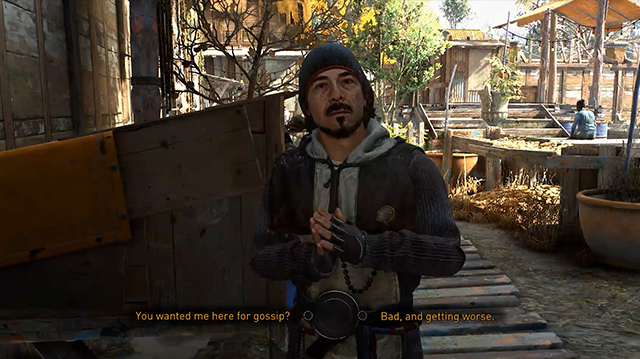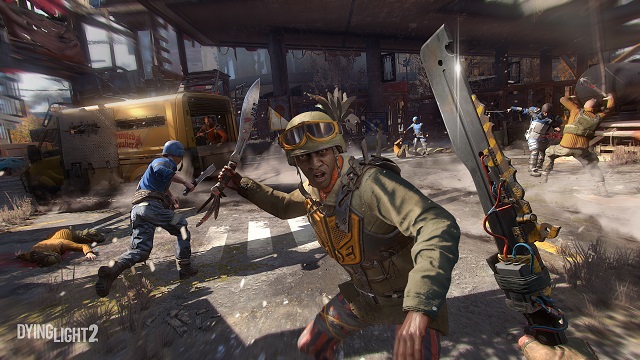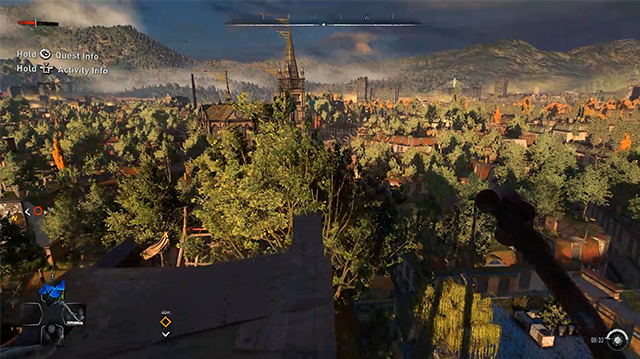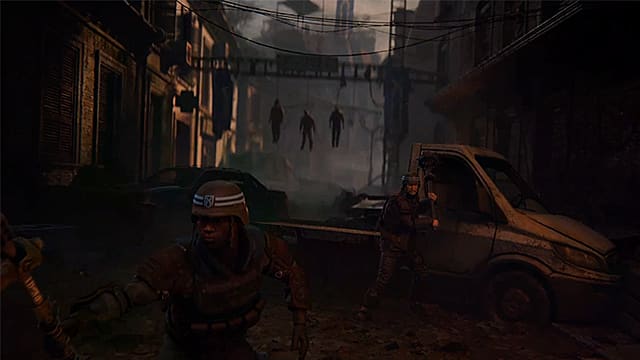I had a dangerous choice to make. It was the middle of the night, and the city streets of Dying Light 2, largely subdued during the day, were now teeming with aggressive Infected. I needed to find shelter, a place to hole up and await the relative safety of daylight.
But the danger of night also presents opportunity. There, enclosed by a chain-link fence, was a Revenant, a badly mutated Infected that is both deadly and durable. Bringing it down, no easy task, would net a large amount of experience and unlock containers holding potentially high-level weapons and crafting components.
The risk to my life, though, was immense. Throwing caution to the wind, I climbed the fence and drew my weapon, crudely crafted from a broken street sign, and the Revenant turned to face me.
Dying Light 2: Stay Human Preview — The New Dark Age

Dying Light 2: Stay Human is a game about choice. I learned this lesson well in a recent hands-on preview hosted by developer Techland. The world has advanced 20 years past the initial zombie apocalypse in the original Dying Light. What remains of humankind is trying to live in the harsh, post society reality.
What remains of civilization is fractured into factions, and it is up to you to take sides, choose allies, allocate resources, and make decisions that permanently alter the world around you.
With this setup in mind, I began my adventure in the fictional city of Harran. Aiden Caldwell, the protagonist of Dying Light 2, is on a mission to find his missing sister. I start by talking to the Survivors, a group of people trying to rebuild a cooperative community. They may be able to help, but first, they need something from me.
Sophie is one of the Survivor leaders, and Barney, her brother, is missing. Dialogue choices allow me to push back on the potential busy work, but I elect to play nice and agree to help with the search.

Dying Light 2 continues the first-person parkour-based gameplay of its predecessor. I climb from car to car, avoiding the slowly shambling Infected as I move toward my objective. Nearing the end of a street, I climb atop a low building and begin leaping from roof to roof while the decaying, zombified population shuffle below, unaware of my traversal above.
The action is fast and fluid, noticeably more responsive than the first Dying Light. The city is also much more vertical. While much of the action previously takes the form of hopping from cars and fences, like a zombie-themed game of “The Floor is Lava,” now I’m ascending multi-story buildings, using lights poles as stepping stones to cross streets.
Eventually, I come to what appears to be a former department store, the last known whereabouts of the missing person. It’s daylight outside but pitch black within. The Infected avoid the light, so the odds are quite good that there will be a sizable number of them inside.
I could come back at night when the streets are busier and the interior is likely to be deserted, but I decide to take my chances. I crawl into a low opening and am greeted with seemingly dozens of Infected. I pull out my weapon, a curved blade bolted to a short pole, and begin to cut through the masses.
It is clear that I am going to be quickly overwhelmed. In my desperation, I spy a large chandelier hanging from the ceiling. Climbing it grants me access to the second story and a reprieve from most of the Infected. A few, however, are talented climbers themselves and give chase. Cornered, I stand my ground.
Stand and Fight

Combat in Stay Human is very similar to the original Dying Light. I swing my blade in wide arcs, chipping away at the health bars of the Infected. I can block most incoming attacks and use quick dodges to circle my foes. Swinging a makeshift weapon about is intentionally crude, and the bloody affair sprays the walls in crimson as I whittle down my adversaries, lopping off limbs and heads as I go.
Enemies have a stagger gauge; depleting that with rapid attacks enables you to springboard off them and strike down devastating blows from the air. I found the interaction between parkour and combat almost seamless and very enjoyable.
Eventually, I reduce all the infected to quivering masses of gore, and I rescue Barney. Barney has a bit of an attitude, a far cry from his sunnier and more cooperative sister. Indeed, throughout my entire multi-hour preview, I find NPC’s tend to have strong identities and are distinct, well-acted characters. It’s a massive improvement over the largely generic cast in the previous entry of the series.
I continue following the story threads and press through sections of the main campaign. I won’t spoil anything, but narrative-relevant objectives offer compelling reasons to press forward. Missions had me sprinting across rooftops, sneaking and assassinating members of rival factions, and at one point racing from a collapsing windmill in a frenetic parkour puzzle that had my heart pounding.
Dying Light 2 is so far a carefully paced mix of flowing movement, brutal combat, puzzle-solving, and explosive set pieces.
Choose Your Own Adventure

The city is a massive sandbox, an open area in which to play. I frequently went off the beaten path to find weapon parts to scavenge or discover new side quests. There are key structures that can be captured, similar to outposts from the Far Cry series. And there are optional bosses, like my aforementioned Revenant friend.
Battling these monstrous enemies is extremely challenging. The size of the Revenant belies the speed of its powerful leaping attack. It has powerful melee attacks, an AoE toxic mist, and a thrown projectile.
I opted for a close-range strategy, using quick steps to close distance and land attacks with a lead pipe. I would quickly dart back or to the side to avoid the answering blows. It worked well until the Revenant summoned an infected hoard. Suddenly, my avenues of dodging and weaving were cut off.
I spied a red propane tank. Recognizing the international video game code for explosives, I grabbed the container, lit it, and threw it. The ensuing explosion cleared half of the surrounding mob and took a good chunk of the Revenant’s health for good measure. The satisfaction was short-lived, however, as multiple beastly screams rang out in the night. The infected are attached to sound, a key detail I forgot. A larger mob bore down on me, more aggressive than the first.

It took time, but my hit-and-run tactics won the day. Killing the Revenant opened the hatch on a sealed building, granting access to some new equipment. Gear now includes six distinct classes of armor, including shirts, pants, bracers, etc. There is a Borderlands-like randomization of stat modifiers on the gear, a significant step to further RPG-ify Dying Light 2.
In my time with Dying Light 2, I saw many interesting things. Different districts of the city have their own stories, characters, and factions. I searched for explosives, investigated murders, and even sailed through the skies on a hang glider. One minute I was leaping from a rooftop and crushing the head of an infected walker to break my fall; the next, I was carefully weighing dialogue choices, hoping to make allies or avoid conflicts.
As my time with Dying Light 2 came to an end, I found myself wanting more. Improvements to storytelling, combat, and movement have me intrigued. There is a lot that could go wrong between now and its February 4 release, but if the Dying Light 2: Stay Human preview is indicative of the final product, this could be the next great franchise unfolding before our eyes.







Published: Nov 16, 2021 03:04 am